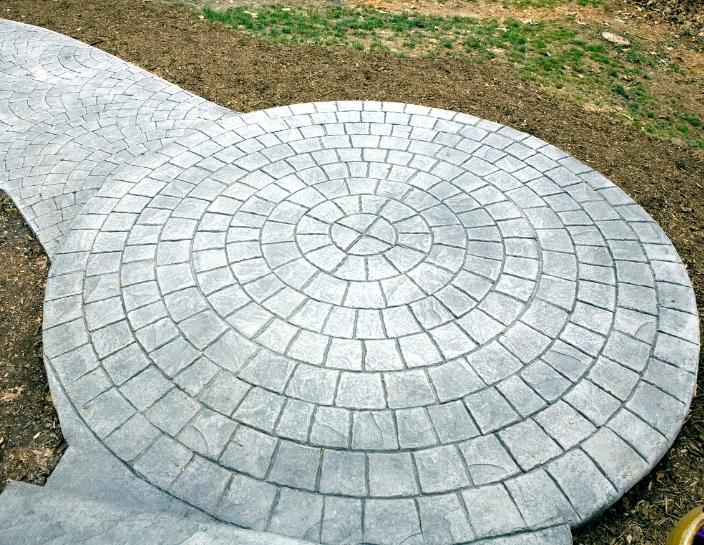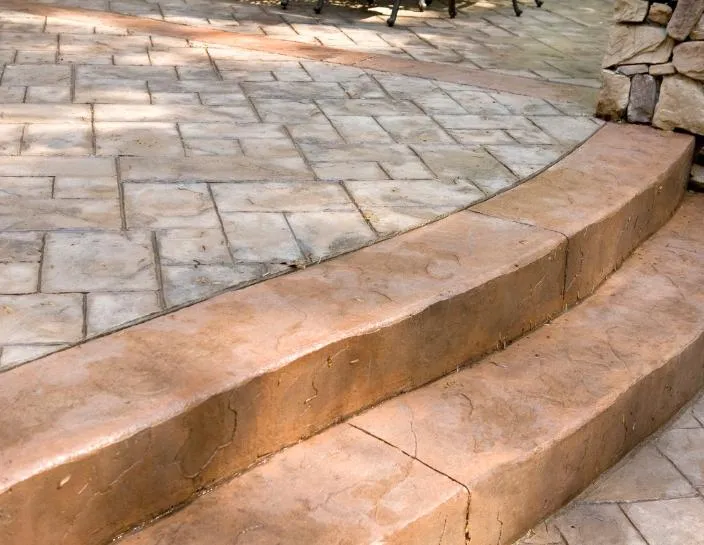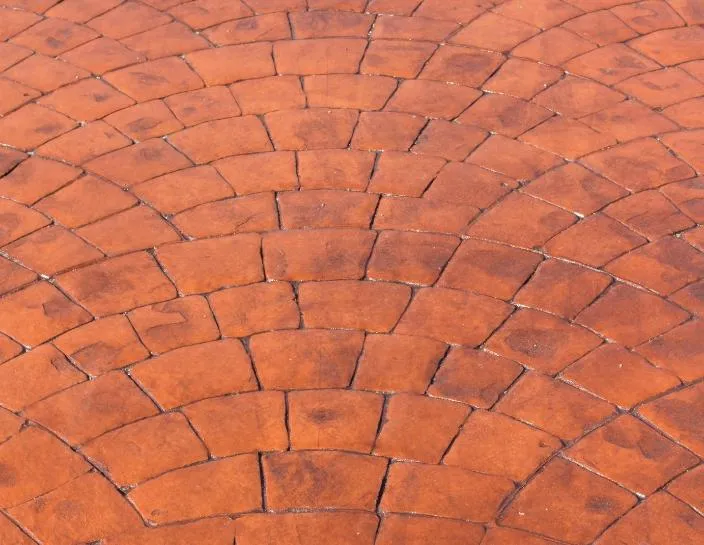
Stunning Stamped Concrete Options for Your Driveway

Choosing the Perfect Stamped Concrete Patterns for Your Project
Are you struggling to choose the right stamped concrete pattern for your project? This guide will help you navigate the selection process, exploring popular patterns, color options, and maintenance considerations. By understanding your project requirements and working with professionals, you'll be able to select a stamped concrete pattern that enhances your space and stands the test of time. Learn how to make an informed decision that balances aesthetics, durability, and practicality for your specific needs.
Key Takeaways
Stamped concrete patterns offer versatile design options with durability and low maintenance benefits
Color selection and texture choices significantly impact the final look of stamped concrete projects
Experienced contractors are crucial for proper installation and pattern selection of stamped concrete
Regular maintenance, including cleaning and sealing, is essential for preserving stamped concrete patterns
Long-term care involves prompt repairs and protection from harsh chemicals to maintain pattern integrity
Understanding Stamped Concrete Patterns

Stamped concrete patterns offer versatile design options for outdoor spaces. These patterns mimic various textures, from brush and broom finishes to acid-etched and iron-stamped looks. Key characteristics include durability and low maintenance, while benefits range from cost-effectiveness to enhanced curb appeal. Understanding these aspects helps in selecting the perfect stamped concrete pattern for any project.
Key Characteristics of Stamped Concrete Patterns
Stamped concrete patterns boast exceptional durability and low maintenance requirements, making them ideal for various landscape projects. These patterns often incorporate epoxy or resin-based sealers, enhancing their resistance to wear and tear while providing a glossy finish that complements the chosen design, such as the popular herringbone pattern.
The versatility of stamped concrete patterns allows for seamless integration with existing architectural elements and natural surroundings. Contractors can customize colors and textures using specialized solvents and pigments, creating unique designs that mimic natural stone, brick, or even wood, effectively transforming outdoor spaces without the need for costly materials.
Benefits of Using Stamped Concrete Patterns
Stamped concrete patterns offer numerous benefits, including the ability to mimic natural materials like ashlar stone and rock at a fraction of the cost. These patterns can be applied to various surfaces, from countertops to outdoor decks, providing a durable and attractive finish that resists evaporation and weathering.
The versatility of stamped concrete patterns allows homeowners to create unique designs that complement their existing architecture and landscaping. Whether replicating the look of a rustic stone patio or adding a decorative border to a pool deck, these patterns offer endless possibilities for customization while maintaining the strength and longevity of concrete.
Evaluating Your Project's Requirements
Selecting the right stamped concrete pattern involves careful evaluation of project requirements. This process includes assessing functional needs, considering aesthetic preferences, and determining budget constraints. Factors like pavers, abrasion resistance, dye options, polyurethane sealers, and grout choices play crucial roles in decision-making. Understanding these elements ensures a successful stamped concrete project that meets both practical and visual goals.
Assessing the Functional Needs of Your Space

Assessing the functional needs of a space is crucial when choosing stamped concrete patterns for driveways, patios, or other areas. Contractors evaluate factors like traffic flow, weight-bearing requirements, and climate conditions to determine the most suitable concrete mix and pattern. For high-traffic areas, denser concrete with added pigments can enhance durability while maintaining aesthetic appeal.
The intended use of the space also influences pattern selection. A patio might benefit from a textured finish for slip resistance, while a driveway may require a smoother surface for easy snow removal. Contractors consider these factors along with the building material of surrounding structures to ensure the stamped concrete complements the overall design:
Traffic intensity and type
Weather exposure
Desired texture and slip resistance
Integration with existing architecture
Maintenance requirements
Considering Aesthetic Preferences and Style
When selecting stamped concrete patterns, homeowners often consider their aesthetic preferences and existing architectural style. The choice of mat and tool designs can significantly impact the final look, with options ranging from natural stone textures to geometric patterns. Color selection plays a crucial role, with concrete mixers offering a variety of pigments to complement or contrast with the surrounding landscape.
The versatility of stamped concrete allows for creative combinations of patterns and colors. Homeowners can opt for a single, uniform design or incorporate borders and accents using different mats and metal stamps. This flexibility enables the creation of unique outdoor spaces that reflect personal style while maintaining the durability and low maintenance benefits of concrete.
Determining Budget Constraints for Your Project
Determining budget constraints for a stamped concrete project involves considering the cost of materials, labor, and equipment. The pressure to balance quality with affordability often leads homeowners to explore various decorative concrete options. Factors such as the complexity of the chosen mold pattern and the size of the project area significantly influence the overall cost.
To manage expenses effectively, homeowners can subscribe to industry newsletters for cost-saving tips and compare quotes from multiple contractors. Some may opt for simpler patterns or smaller project areas to reduce costs while still achieving a desirable aesthetic. By carefully evaluating these factors, homeowners can find a balance between their desired stamped concrete design and their budget limitations.
Exploring Popular Stamped Concrete Patterns
Stamped concrete patterns offer diverse options for floors, from traditional stone and brick designs to modern geometric shapes and custom looks. Popular choices include flagstone patterns for kitchens and outdoor spaces, balancing aesthetics with wear resistance. These patterns can mimic natural materials while providing durability and easy maintenance, making them ideal for high-traffic areas. Selecting the right pattern involves considering style preferences, functionality, and long-term performance.
Traditional Stone and Brick Patterns

Traditional stone and brick patterns remain popular choices for stamped concrete projects. These designs incorporate the timeless appeal of natural materials like slate and brick, while utilizing the durability of portland cement. Contractors often use ultraviolet-resistant sealers to protect these patterns from sun damage, ensuring long-lasting beauty.
Homeowners can choose from a variety of stone and brick patterns to suit their architectural style and personal preferences. Common options include:
Ashlar slate for elegant patios
Herringbone brick for classic driveways
Cobblestone for rustic walkways
Flagstone for natural-looking pool decks
These patterns offer the aesthetic of natural materials with the added benefits of concrete's strength and low maintenance requirements.
Modern Geometric Patterns
Modern geometric patterns offer a contemporary twist to stamped concrete designs, incorporating clean lines and symmetrical shapes. These patterns often feature interlocking tiles or repeating shapes that create a visually striking surface. Contractors apply a water-based release agent to ensure clean separation between the stamping mats and wet concrete, resulting in crisp, well-defined edges.
Homeowners can choose from various geometric patterns, including hexagons, diamonds, and squares, to complement modern architecture. These designs often require a skilled coat application to maintain consistency across the surface. Geometric patterns also offer practical benefits, as their uniform surface can make deicing and maintenance easier in colder climates:
Pattern Type
Characteristics
Best Used For
Hexagon
Six-sided, honeycomb-like
Patios, walkways
Diamond
Angular, dynamic look
Driveways, pool decks
Square
Clean, grid-like appearance
Indoor floors, outdoor spaces
Customized Patterns for Unique Looks
Customized stamped concrete patterns offer homeowners the opportunity to create unique looks tailored to their specific preferences. Skilled contractors use specialized trowels and stamps to imprint custom designs, incorporating elements like wood grain textures or intricate geometric patterns. These personalized touches can transform ordinary concrete surfaces into works of art, adding value and character to any property.
The customization process often involves combining different stamping techniques with colored powder releases and paint applications. Contractors can create multi-layered designs that mimic the appearance of exotic materials or replicate specific motifs requested by clients. This level of customization allows homeowners to achieve a one-of-a-kind look that perfectly complements their home's architecture and landscape design.
Choosing Colors and Finishes for Stamped Concrete
Choosing colors and finishes for stamped concrete slabs is crucial for creating the desired look and feel. This process involves selecting color schemes that complement the property, understanding different textures and finishes, and adding personal touches with color. By considering these factors, homeowners can achieve a unique and attractive stamped concrete surface that enhances their outdoor space.
Selecting Color Schemes That Complement Your Property
Selecting color schemes for stamped concrete involves considering the existing colors of the property's exterior and landscape. Homeowners often choose hues that complement their home's siding, trim, or stonework, creating a cohesive look. For example, a house with warm-toned brick might pair well with earth-toned concrete in shades of tan or brown.
Contractors can help homeowners evaluate the surrounding environment to select colors that enhance the overall aesthetic. They might suggest using contrasting colors for borders or accent areas to create visual interest. Additionally, considering the intensity of sunlight in the area can help determine whether lighter or darker shades will work best for maintaining the desired appearance over time.
Understanding Different Textures and Finishes
Stamped concrete offers a variety of textures and finishes that can significantly impact the overall look of a project. Contractors use different stamping mats and tools to create textures ranging from smooth and sleek to rough and rustic. These textures not only affect the appearance but also influence factors like slip resistance and maintenance requirements.
Finishes for stamped concrete include matte, semi-gloss, and high-gloss options, each providing a distinct aesthetic. Matte finishes offer a more natural look, while glossier options can enhance color vibrancy and create a wet appearance. Homeowners should consider the intended use of the space and local climate when selecting a finish, as some may be more suitable for specific environments or traffic levels.
Tips for Adding a Personal Touch With Color

Adding a personal touch with color in stamped concrete projects involves experimenting with custom color combinations. Homeowners can work with contractors to create unique blends that reflect their personality or complement specific design elements. For instance, mixing two base colors can produce a variegated effect that mimics natural stone or adds depth to a monochromatic scheme.
Accent colors offer another way to personalize stamped concrete surfaces. Contractors can apply highlight tones to raised areas of the pattern or use contrasting colors for borders and inlays. This technique creates visual interest and can tie the concrete into the overall landscape design. Popular accent options include:
Metallic flakes for a subtle shimmer
Darker shades in recessed areas for a shadowed effect
Bright colors for focal points or artistic elements
Earth tones for a natural, weathered appearance
Working With Professionals and Resources
Collaborating with professionals and accessing resources is crucial for successful stamped concrete projects. Experienced contractors ensure proper installation, while pattern inspiration resources help homeowners choose designs that suit their style. This section explores how to find skilled installers and where to gather ideas for stunning stamped concrete patterns.
Finding Experienced Contractors for Installation
Finding experienced contractors for stamped concrete installation involves researching local companies and checking their credentials. Homeowners can start by seeking recommendations from friends, family, or online review platforms. It's crucial to verify that potential contractors have the necessary licenses, insurance, and certifications specific to concrete work.
To ensure quality workmanship, homeowners should request portfolios and references from contractors. Experienced professionals often showcase their previous projects and can provide contact information for satisfied clients. Comparing quotes from multiple contractors helps in understanding the market rates and the scope of services offered:
Contractor Evaluation Criteria
Importance
Years of Experience
High
Portfolio Quality
High
Client References
Medium
Licensing and Insurance
Critical
Warranty Offered
Medium
Resources for Pattern Inspiration and Ideas
Homeowners seeking inspiration for stamped concrete patterns can explore online galleries and design websites. These platforms showcase a wide range of projects, from traditional to contemporary designs, helping individuals visualize possibilities for their own spaces. Many concrete manufacturers and suppliers also offer virtual design tools that allow users to experiment with different patterns and color combinations.
Local showrooms and home improvement stores often display samples of stamped concrete patterns, providing a hands-on experience for texture and color selection. Attending home and garden shows can also expose homeowners to the latest trends in stamped concrete design, with experts on hand to answer questions and provide guidance on pattern selection for specific project needs.
Maintenance Considerations for Stamped Concrete Patterns
Maintaining stamped concrete patterns ensures their longevity and appearance. This section covers best practices for preserving the look, common issues and solutions, and long-term care tips. Homeowners will learn how to protect their investment, address potential problems, and keep their stamped concrete surfaces looking great for years to come.
Best Practices for Preserving Appearance
To preserve the appearance of stamped concrete patterns, regular cleaning is essential. Homeowners should sweep or blow debris off the surface weekly and wash it with a mild detergent and water solution monthly. For tougher stains, a pressure washer set at a low PSI can be effective, but care must be taken not to damage the surface.
Applying a quality sealer every two to three years helps protect stamped concrete from wear and fading. Homeowners should choose a sealer compatible with their concrete type and follow manufacturer instructions for application. During winter, using sand instead of salt for deicing can prevent surface damage:
Maintenance Task
Frequency
Purpose
Sweeping/Blowing
Weekly
Remove debris
Washing
Monthly
Clean surface
Sealing
Every 2-3 years
Protect from wear
Deicing (sand)
As needed
Prevent surface damage
Common Issues and How to Address Them
Common issues with stamped concrete patterns include fading, cracking, and efflorescence. Fading often results from sun exposure or improper sealing, which contractors can address by applying a new coat of tinted sealer. Cracking may occur due to ground settling or extreme temperature changes, requiring professional repair using color-matched epoxy or polyurethane fillers.
Efflorescence, a white powdery substance that forms on the surface, can be removed with a mild acid wash or specialized cleaner. To prevent future issues, homeowners should follow these maintenance steps:
Reapply sealer every 2-3 years
Clean spills promptly to prevent staining
Avoid using deicing salts in winter
Address cracks and chips quickly to prevent further damage
Use proper cleaning techniques to maintain the pattern's integrity
Long-Term Care Tips for Stamped Concrete Patterns
Long-term care for stamped concrete patterns involves regular inspections to catch potential issues early. Homeowners should examine their surfaces annually for signs of wear, cracking, or discoloration. They can extend the life of their stamped concrete by promptly addressing any problems and following a consistent maintenance schedule.
Protecting stamped concrete from harsh chemicals and excessive weight helps maintain its integrity over time. Homeowners should use plastic shovel blades for snow removal and place protective pads under heavy furniture or equipment. Applying a penetrating sealer every few years can also help resist stains and moisture damage, preserving the pattern's appearance for decades.
Frequently Asked Questions
What factors should I consider when choosing stamped concrete patterns for my project?
Consider your project's style, surrounding architecture, budget, maintenance requirements, and climate. Choose patterns that complement your space, withstand local weather conditions, and fit your design preferences. Evaluate color options, texture variations, and pattern sizes to ensure a cohesive and visually appealing result.
How do popular stamped concrete patterns differ in appearance and application?
Stamped concrete patterns vary in appearance and application, ranging from natural stone textures to geometric designs. Popular options include brick, slate, and wood plank patterns. Each pattern requires specific stamping tools and techniques, with some better suited for certain areas like patios, driveways, or pool decks.
Can stamped concrete patterns be customized with different colors and finishes?
Yes, stamped concrete patterns can be customized with various colors and finishes. Decorative concrete contractors offer a wide range of pigments, stains, and textures to create unique designs. From earth tones to vibrant hues, and matte to glossy finishes, the possibilities for personalized stamped concrete are extensive.
What role do professionals play in selecting and implementing stamped concrete patterns?
Professionals play a crucial role in selecting and implementing stamped concrete patterns. They assess the project requirements, recommend suitable designs, ensure proper surface preparation, apply color hardeners and release agents, and expertly imprint the chosen pattern to achieve a high-quality, durable finish that enhances the property's aesthetics.
How does maintenance differ for various stamped concrete patterns?
Maintenance for stamped concrete patterns varies based on the design complexity, texture depth, and sealer type used. Intricate patterns may require more frequent cleaning and resealing, while simpler designs are easier to maintain. Regular sweeping, occasional power washing, and periodic resealing are essential for all stamped concrete surfaces to preserve their appearance and durability.
Conclusion
Selecting the ideal stamped concrete pattern is crucial for enhancing outdoor spaces with durability, aesthetics, and value. By carefully evaluating project requirements, exploring popular designs, and considering color schemes, homeowners can create unique and functional surfaces that complement their property. Working with experienced contractors and utilizing available resources ensures proper installation and maintenance of stamped concrete patterns. Ultimately, investing time in choosing the perfect stamped concrete pattern results in a long-lasting, attractive addition to any property that balances form and function.
If you are in need of a stamped concrete project visit us at www.vicknaircontractors.com